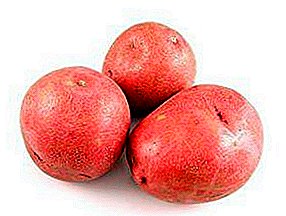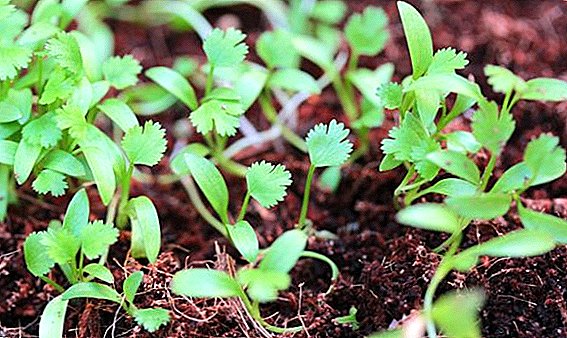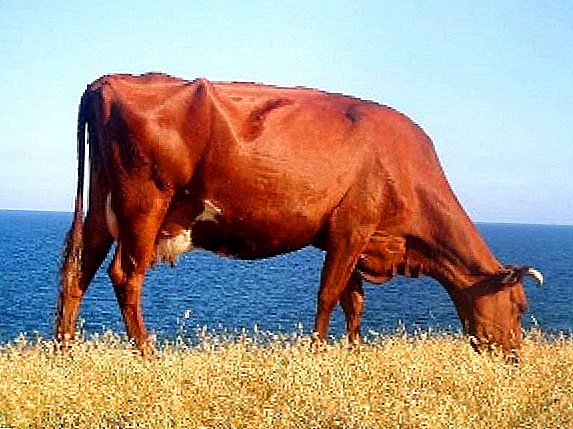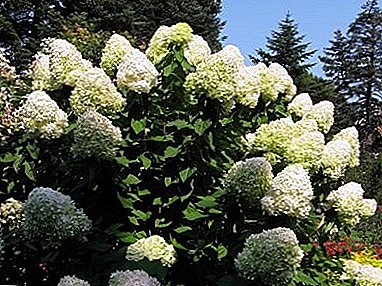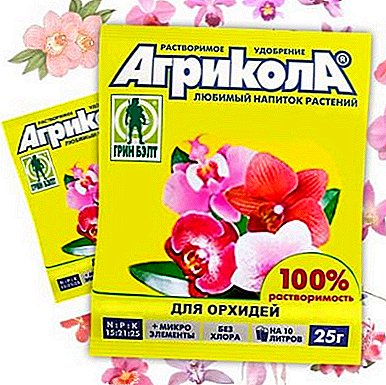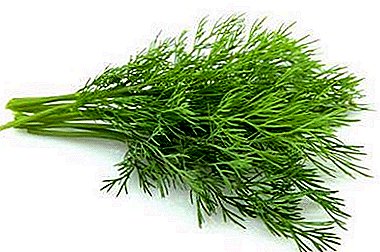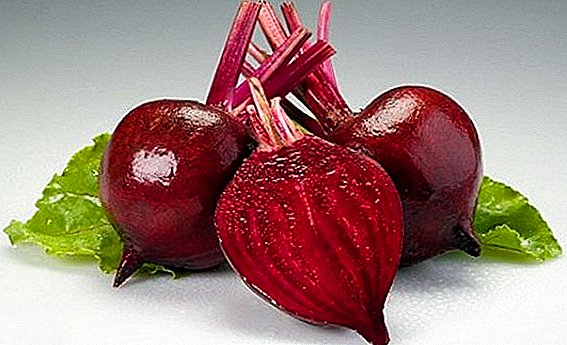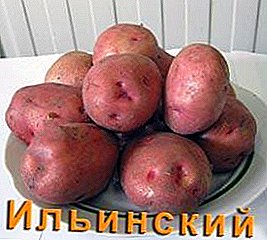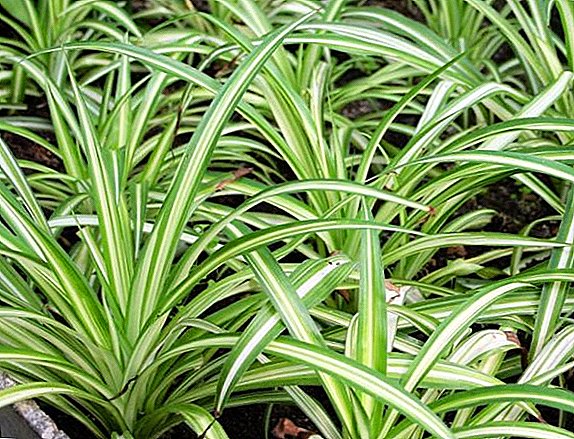 Chlorophytum is a perennial shrub with white-green narrow leaves that exists in almost every home. The plant is not demanding to care. And in this article we will talk about how to plant chlorophytum and care for the plant. We will understand what ways you can multiply chlorophytum, tell about the pests and diseases of this plant
Chlorophytum is a perennial shrub with white-green narrow leaves that exists in almost every home. The plant is not demanding to care. And in this article we will talk about how to plant chlorophytum and care for the plant. We will understand what ways you can multiply chlorophytum, tell about the pests and diseases of this plant
Did you know? Chlorophytum cleans the room from all bacteria and harmful substances in 24 hours by almost 100%.
Features of the maintenance and care of chlorophytum
Proper care of chlorophytum includes several factors: lighting, watering and feeding, pruning and disease control.
Lighting and temperature
Chlorophytum feels great in any light. It is important to remember that direct light dries the ground and makes the leaves pale, if you put the plant in the shade, it will lead to fading of the leaves. Due to poor lighting, leaves near the chlorophytum begin to break.
 It is best to put the plant for 3-4 hours a day in the sun, and then remove it in the shade. When choosing a temperature, the main thing is to avoid overcooling of the plant. The temperature should not be below 10 ° C. Constant heat will also be bad for the chlorophytum. The optimum temperature for this plant is + 18 ° С.
It is best to put the plant for 3-4 hours a day in the sun, and then remove it in the shade. When choosing a temperature, the main thing is to avoid overcooling of the plant. The temperature should not be below 10 ° C. Constant heat will also be bad for the chlorophytum. The optimum temperature for this plant is + 18 ° С.
Watering and humidity
In this section we will look at how to spray and water chlorophytum. In hot periods of the year or active growth the main thing is to take care of abundant watering of chlorophytum, about once every 2-4 days.
In winter watering should be reduced, it will be enough once a week.
Failure to follow these rules leads to rotting roots.
If you have dry air in your home, you will need to spray the leaves of the plant regularly, in any season. And the hotter it is, the more often this procedure should be carried out, it also depends on the season and the availability of a number of batteries and heating devices. Spraying and watering are carried out on different days, but with the same frequency.
Fertilizer and top dressing of the soil
The best time for feeding chlorophytum from April to September. If you have an ornamental plant, fertilization is carried out twice a month. Fertilize better with complex fertilizers, and no more than once a month to water the plant with sweetened water. To do this, dissolve a teaspoon of sugar in one liter of water.
 Many gardeners wonder why the leaves are drying at the chlorophytum, and this is their answer. It means that It should be weekly feeding plants with all the necessary nutrients.
Many gardeners wonder why the leaves are drying at the chlorophytum, and this is their answer. It means that It should be weekly feeding plants with all the necessary nutrients.
In addition, fertilization ensures the growth of chlorophytum and the formation of new children.
Did you know? One chlorophytum is enough to reduce the effects of nitrogen oxides in the kitchen, where the gas burns.
Transplanting and pruning plants
In this section, we will tell you when to replant chlorophytum,and how to prune
It is impossible to grow a smart bush of a plant if you don’t transplant it at least once.
There are several reasons why a plant needs a transplant:
1. A small pot;
2. Poor soil.
In order to properly transplant a plant, one should prepare a flower pot which will be several centimeters more than the previous one in diameter, new soil and chlorophytum itself.
The following transplant stages are available: 
- First you should loosen the soil mixture in the pot, so as not to damage the root system of the plant when you take it out. Plastic pot can be mastered.
- After the shrub has been removed from the pot, you should carefully straighten the root system of the plant, because it takes the form of the old pot. It is also necessary to remove excess land from the roots.
- Then the bush moves to the selected pot with the updated ground.
- After planting, pour chlorophytum.
Important! Do not cut on green living tissue.
If the tips of the leaves are brown - cut them just above the edge of a healthy leaf.
Reproduction of chlorophytum at home
Chlorophytum should be periodically freed from regrown children. This will facilitate the life of the plant and preserve the vitality of chlorophytum. From young bushes grow new plants. In this section, we will analyze how chlorophytum can be propagated by rooting lateral shoots and dividing the mother plant. Also tell about complex reproduction - seeds.
 The soil for chlorophytum should be as follows: 2 parts of sod land, 2 hours of humus, 1 hour of sand, 2 hours of leafy soil. The optimum acidity of the soil mixture is pH 6.1 - 7.5.
The soil for chlorophytum should be as follows: 2 parts of sod land, 2 hours of humus, 1 hour of sand, 2 hours of leafy soil. The optimum acidity of the soil mixture is pH 6.1 - 7.5.
Important! Sterilize the mixture before use.
Rooting side shoots, offspring
Siblings are side shoots that develop from the main plant. They take root within 2-3 weeks. Young outlet should be rooted, not separating it from the main chlorophytum. For breeding take small offspring, as adults will be sick. After separation, the sockets are left in the water for a few days in order for them to take roots. The separated sockets are separated from the main plant and planted in small pots with a soil mixture.
Uterine division
Chlorophytum has good roots that can be easily divided into several parts.
To do this, pull the plant out of the pot and free it from the old soil. After that, with a sharp knife, divide the roots into separate parts. It is necessary to divide so that on each part there are points of growth.
Then, place the slices sprinkle with crushed charcoal and plant each part of the bush in pots with a suitable substrate.
During the month after planting, water the chlorophytum, and then take care of the plant as an adult.
Seed propagation
 Seed propagation is a very long and difficult process. It is used in the event that chlorophytum does not form children.
Seed propagation is a very long and difficult process. It is used in the event that chlorophytum does not form children.
Seeds gather in November, since at this time the seed pods dry up. In one such box 10-12 seeds.
After harvesting, the seeds are soaked in water for a day. It should be changed frequently. Then the seeds are sown in a wet mixture of sand and peat and spread them over the surface, gently pushing it into the soil. Ploshka where temporarily planted seeds, cover with polyethylene and place on the battery. This will provide bottom heating. You should also ventilate and spray the seeds. Germination begins after six weeks. With the appearance of several leaves, the seedlings dive.
Possible diseases and pests of chlorophytum, how to deal with them
If properly care for the plant, then diseases and pests will not damage chlorophytum.
Of pests for chlorophytum, thrips, nematodes and mealybugs are dangerous.
Thrips. Larvae and adults of parasites suck out cell sap. This causes yellow spots or streaks, which then merge. The damaged tissue dies off and holes are formed. The flowers lose their decorativeness, the leaves wither and fall.
Before you start fighting these pests, other plants should be examined for thrips.
The place where the parasite-laden plants stood was thoroughly cleaned. Before treatment with an insecticide, wash the plant in the shower.
 Best suited means "Aktelik". It has a very sharp smell. A vial of product should be dissolved per liter of water. Spray the plant with a solution, then put a transparent plastic bag on the plant, which can be removed after 24 hours.
Best suited means "Aktelik". It has a very sharp smell. A vial of product should be dissolved per liter of water. Spray the plant with a solution, then put a transparent plastic bag on the plant, which can be removed after 24 hours.
Nematodes
Plants afflicted by these parasites are stunted, and in warm weather the leaves curl. On the roots appear round and elongated lesions. At first they have a dull black color, and then become dark brown.
You can heat treat the roots. The affected plants are removed from the soil, and the roots are washed off the ground. The roots or the whole plant bathe in water at 55 ° C. At this temperature, the marmode died.
Mealybug
These parasites are easily recognizable by the white wax bloom that looks like cotton wool. Chervets suck the juices of young shoots, buds, leaves, and thus inhibit the growth of chlorophytum.
The fight method is simple. With a soft brush or cotton buds that are soaked in soapy water, we clean the plant from the insects. And then we spray with solution of green soap with an interval of 5-10 days.
With a strong defeat spray spray "Aktar", "Biotlin" or "Calypso" with an interval of 7-14 days.
As for diseases, they arise because of a violation of the rules of plant care.
If your chlorophytum begins to dry sheets with a tip, then most likely the problem is an excess of sodium in the ground. It is necessary to stop fertilizing the plants with top dressings containing sodium.
Many gardeners ask on the forums, why do black leaves have chlorophytum. This means that in hot weather the ground remains dry for a long time, and the humidity of the air is too low.
Chlorophytum begins to turn yellow for several reasons:
 1. Waterlogging (rotting roots). In this case, the plant should be transplanted into a new land, removing the rotten and blackened roots.
1. Waterlogging (rotting roots). In this case, the plant should be transplanted into a new land, removing the rotten and blackened roots.
2. Lack of lighting. It is necessary to rearrange the chlorophytum to the window or organize artificial lighting.
3. Lack of nutrients. When chlorophytum grows, the roots become very crowded in the old pot. In this case, the plant should be transplanted into a pot larger than the previous one by 3-4 cm and fertilized with top dressings.
If the leaves fall in winter, it means that the chlorophytum is not enough light or it is too hot.
In this article, we sorted out how to care for chlorophytum. Also reviewed types of reproduction found out everything about inPossible parasites and diseases of this plant.



